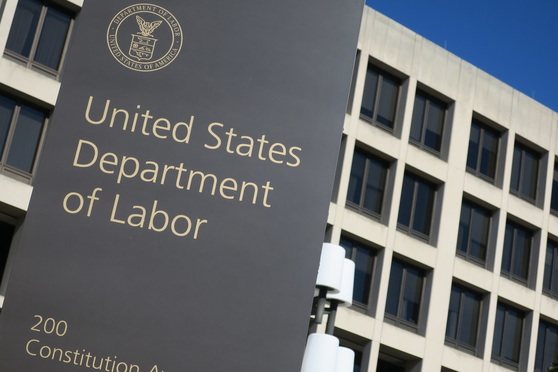DOL's New Pay Guidance Is 'Optics Shift,' but Maybe Not Much More
Management-side lawyers were waiting and watching for new guidance from the U.S. Labor Department on compensation practices. One lawyer said the new directive is more a "technical revision" of Obama-era policies.
August 28, 2018 at 12:05 PM
6 minute read
 U.S. Labor Department headquarters in Washington. Credit: Mike Scarcella
U.S. Labor Department headquarters in Washington. Credit: Mike Scarcella
The Trump administration wants to provide federal contractors more voice in U.S. Labor Department pay-disparity investigations, but the agency's long-awaited new guidance may not be the dramatic shake-up that management-side lawyers had hoped to see.
The Labor Department issued a directive late last week that replaced Obama-era policy on how the agency analyzes compensation in discrimination audits. The Labor Department's contract compliance arm conducts these audits, which examine the extent to which contractors are abiding by federal anti-discrimination provisions.
The business community loathed the Obama-era policies, which restricted some of the evidence companies might want to use to show their compensation structures are not discriminatory. The new directive gives greater weight to employers' compensation data sets, allows some anecdotal evidence to explain any pay disparities and promises to provide more transparency.
Labor and employment lawyers who reviewed the new guidance said the language is vague and largely maintains much of the structure of the previous guidance, including a strong reliance on statistics and the discretion of federal compliance officers.
“There is clearly an optics shift. The shift is, 'We will work with contractors more closely. We will be more accommodating,'” said former Obama-era Labor Department solicitor Patricia Smith, now senior counsel at the National Employment Law Project. “But I don't know what that means in reality.”
New enforcement cases will test the scope of the Labor Department guidance. The Labor Department's old guidance was the centerpiece of investigations and enforcement actions against major U.S. companies, including Google Inc., Oracle Corp. and JPMorgan Chase & Co. An adverse ruling by the Labor Department against a federal contractor could jeopardize current and future opportunities worth tens of millions of dollars.
Business advocates decried the Obama-era rules as lacking transparency. Critics alleged Labor Department investigators could, among other things, determine job categories to compare and also shun anecdotal evidence. Proponents of the scheme said the agency's investigations are purposefully independent.
Businesses groups, for instance, complained the “pay analysis groups” in the Obama-era guidance unfairly allowed Labor Department compliance officials to compare pay across job groups. The new directive maintains the contract compliance office's ability to create these groups, but it acknowledges that employers can present anecdotal evidence to provide more context to pay analysis.
“It doesn't make a lot of changes from the old one,” said Larry Lorber, senior counsel at Seyfarth Shaw in Washington. He said the main difference is that the previous guidance gave the Office of Federal Contract Compliance Programs, or OFCCP, the authority to establish the pay analysis group, whereas the new directive said the agency will consider an employer's report on its compensation.
'More employer-friendly.'
Lorber said the new directive does not take the power away from the agency to determine whether the employer's analysis is reasonable. It instead says a preference is given to the employer's compensation analysis.
“It is more employer-friendly in that regard,” said Lorber, who served previously as a director of the OFCCP. “They are still going to have their compensation reviewed intensively and on a statistical basis. The government also reserves the right to change the [pay] groupings.”
The ability of an employer to offer analytical evidence was also a sticking point under the previous guidance. The new directive, posted below, indicates the agency will accept anecdotal evidence, in addition to statistics.
“Employers were hoping that this would be more user-friendly than it's turned out to be,” Lorber said. “This is a technical revision of what was there before.”
David Goldstein, a Littler Mendelson shareholder and co-chair of the firm's government contractors industry group, said the Labor Department still has discretion in how it analyzes data. Goldstein said he hopes the directive will be implemented and enforced with stated intentions of greater transparency.
“I don't see anything obvious that commits the agency to proceed in that way or requires statisticians to act consistently with those intentions,” Goldstein said.
Both management and employee-side groups said that central to any pay-disparity analysis is how best to compare jobs. Goldstein said there are different interpretations when two jobs are similar.
“In all fairness, compensation discrimination is really difficult. I understand that they are trying to get at a problem that is serious and hard to remedy,” he said. “I don't question the good faith behind this new directive. It's just not clear to me that there is enough here to change what contractors will see in the context of audits.”
Goldstein said he would like to see a more specific discussion of the law and what the law requires the agency to do when it compares similarly situated employees. He said he thought it was a positive step that the Labor Department said it would be less likely to use statistical data when it is not corroborated by anecdotal evidence.
Tammy Daub, of counsel on the employment team at Paul Hastings and a former Labor Department attorney, said the agency has not historically taken on cases that did not have some basis in anecdotal evidence. From the employers' perspective, she said, sometimes there's missing transparency on why an investigation was started in the first place.
“It's been a huge problem that they haven't been transparent with what the indicators are when [companies] ask for information,” she said. “These contractors don't want to be burdened unless they know what the problems are.”
Daub said the Google investigation, which is pending, could have been simplified if more information had been provided at the onset.
She said the new Labor Department directive gives some cause for optimism among federal contractors but “I don't think this was as large a shift as many hoped it would be. The message they are sending is it's a shift but not a total shift.”
Smith, the former Labor solicitor, questions what the newfound “transparency” of the Trump administration's guidance might actually look like in practice. For instance: A contractor in a typical investigation would receive OFCCP findings at the end of an audit, she said. “Does transparency mean they are talking to them all along? It's not clear what some of this stuff means,” Smith said.
She continued: “So many times what you are seeing is gutting what the Obama administration did and they are not gutting it. In some ways they will be more accommodating to contractors but in a lot of these issues may well be optics.”
This content has been archived. It is available through our partners, LexisNexis® and Bloomberg Law.
To view this content, please continue to their sites.
Not a Lexis Subscriber?
Subscribe Now
Not a Bloomberg Law Subscriber?
Subscribe Now
NOT FOR REPRINT
© 2025 ALM Global, LLC, All Rights Reserved. Request academic re-use from www.copyright.com. All other uses, submit a request to [email protected]. For more information visit Asset & Logo Licensing.
You Might Like
View All


Big Tech Is Cozying Up to President Trump. Here's Why Their Lawyers Are Cautiously Optimistic

Supreme Court Agrees to Hear Lawsuit Over FBI Raid at Wrong House
Trending Stories
- 1Judge Sides with Retail Display Company in Patent Dispute Against Campbell Soup, Grocery Stores
- 2Is It Time for Large UK Law Firms to Begin Taking Private Equity Investment?
- 3Federal Judge Pauses Trump Funding Freeze as Democratic AGs Launch Defensive Measure
- 4Class Action Litigator Tapped to Lead Shook, Hardy & Bacon's Houston Office
- 5Arizona Supreme Court Presses Pause on KPMG's Bid to Deliver Legal Services
Who Got The Work
J. Brugh Lower of Gibbons has entered an appearance for industrial equipment supplier Devco Corporation in a pending trademark infringement lawsuit. The suit, accusing the defendant of selling knock-off Graco products, was filed Dec. 18 in New Jersey District Court by Rivkin Radler on behalf of Graco Inc. and Graco Minnesota. The case, assigned to U.S. District Judge Zahid N. Quraishi, is 3:24-cv-11294, Graco Inc. et al v. Devco Corporation.
Who Got The Work
Rebecca Maller-Stein and Kent A. Yalowitz of Arnold & Porter Kaye Scholer have entered their appearances for Hanaco Venture Capital and its executives, Lior Prosor and David Frankel, in a pending securities lawsuit. The action, filed on Dec. 24 in New York Southern District Court by Zell, Aron & Co. on behalf of Goldeneye Advisors, accuses the defendants of negligently and fraudulently managing the plaintiff's $1 million investment. The case, assigned to U.S. District Judge Vernon S. Broderick, is 1:24-cv-09918, Goldeneye Advisors, LLC v. Hanaco Venture Capital, Ltd. et al.
Who Got The Work
Attorneys from A&O Shearman has stepped in as defense counsel for Toronto-Dominion Bank and other defendants in a pending securities class action. The suit, filed Dec. 11 in New York Southern District Court by Bleichmar Fonti & Auld, accuses the defendants of concealing the bank's 'pervasive' deficiencies in regards to its compliance with the Bank Secrecy Act and the quality of its anti-money laundering controls. The case, assigned to U.S. District Judge Arun Subramanian, is 1:24-cv-09445, Gonzalez v. The Toronto-Dominion Bank et al.
Who Got The Work
Crown Castle International, a Pennsylvania company providing shared communications infrastructure, has turned to Luke D. Wolf of Gordon Rees Scully Mansukhani to fend off a pending breach-of-contract lawsuit. The court action, filed Nov. 25 in Michigan Eastern District Court by Hooper Hathaway PC on behalf of The Town Residences LLC, accuses Crown Castle of failing to transfer approximately $30,000 in utility payments from T-Mobile in breach of a roof-top lease and assignment agreement. The case, assigned to U.S. District Judge Susan K. Declercq, is 2:24-cv-13131, The Town Residences LLC v. T-Mobile US, Inc. et al.
Who Got The Work
Wilfred P. Coronato and Daniel M. Schwartz of McCarter & English have stepped in as defense counsel to Electrolux Home Products Inc. in a pending product liability lawsuit. The court action, filed Nov. 26 in New York Eastern District Court by Poulos Lopiccolo PC and Nagel Rice LLP on behalf of David Stern, alleges that the defendant's refrigerators’ drawers and shelving repeatedly break and fall apart within months after purchase. The case, assigned to U.S. District Judge Joan M. Azrack, is 2:24-cv-08204, Stern v. Electrolux Home Products, Inc.
Featured Firms
Law Offices of Gary Martin Hays & Associates, P.C.
(470) 294-1674
Law Offices of Mark E. Salomone
(857) 444-6468
Smith & Hassler
(713) 739-1250








